Explore Tay Ninh - South Vietnam Travel, Asia
Welcome to Tay Ninh, a captivating destination nestled in southern Vietnam. Just a short drive from Ho Chi Minh City and near the Cambodian border, Tay Ninh offers an enriching escape from the bustling cities. With its unique combination of history, culture, and natural beauty, it is a hidden gem just waiting to be found. Whether you're drawn by its religious landmarks, picturesque landscapes, or local culinary delights, Tay Ninh promises an unforgettable experience.
Population: Approximately 1,3 million in 2022.
Economy: Tay Ninh's economy is driven by agriculture, industry, and cross-border trade. It’s known for rice, rubber, and cassava production, with growing industrial zones and significant trade ties with Cambodia.
Landmarks: Famous for the Cao Dai Temple, Ba Den Mountain, and Dau Tieng Lake.
Vietnam
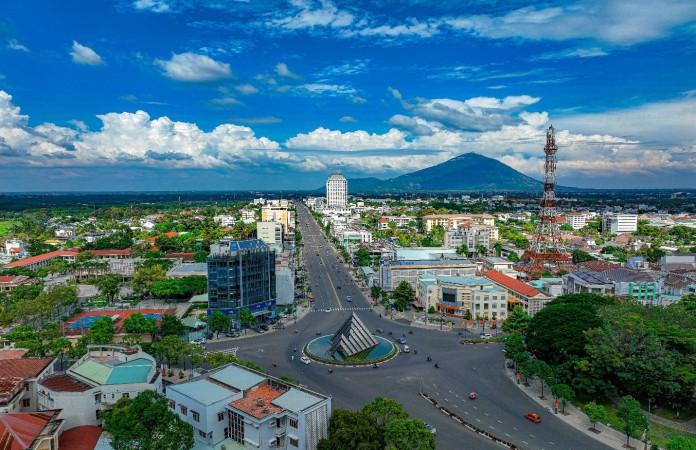
Overview of Tay Ninh
History & Cultural Influence
Tay Ninh's rich history and cultural tapestry make it a fascinating destination. The province is renowned for its role in Vietnamese history and its unique blend of religious influences. One of Tay Ninh's most notable attractions is the Cao Dai Temple, a spiritual and architectural masterpiece. This temple represents the Cao Dai faith, a syncretic religion founded in the 1920s that combines elements of Buddhism, Taoism, Confucianism, and Christianity. The province also reflects a blend of local and foreign cultures, with historical landmarks that tell tales of Vietnam's past.
Interaction with The Locals
Tay Ninh, a province in southern Vietnam, has a population of approximately 1.2 million residents. The local population is a mix of ethnic groups, with the majority being Kinh people, Vietnam's largest ethnic group. The region is known for its friendly and welcoming locals who maintain a blend of traditional Vietnamese culture and unique local customs. This diverse population contributes to the rich cultural tapestry that makes Tay Ninh an intriguing destination for visitors.
Check out our best-selling tours in Vietnam here.
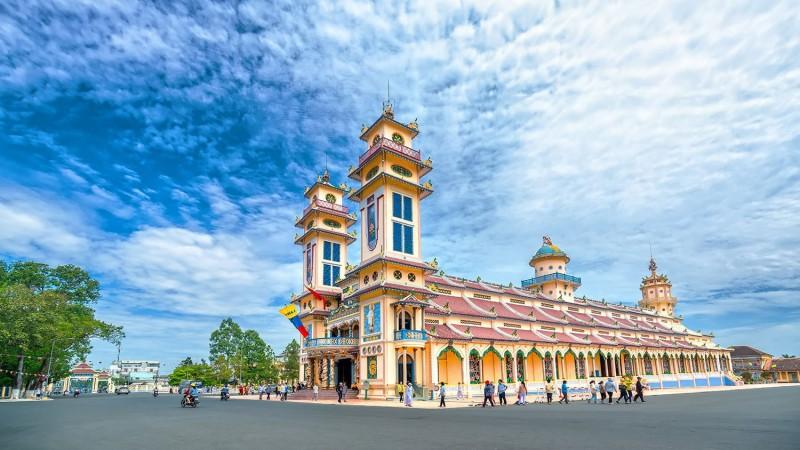
Great Divine Temple of Tay Ninh - © HanoiMoi
Top Attractions in Tay Ninh
Tay Ninh offers a diverse array of attractions that highlight its cultural heritage, natural beauty, and unique local experiences. Each destination provides a unique facet of what makes Tay Ninh a captivating place to visit.
- Cao Dai Temple: The Cao Dai Temple is a masterpiece of religious architecture and a central hub for the Cao Dai faith. Its vibrant colors and intricate designs reflect a blend of various religious influences, making it a must-visit for both spiritual and cultural exploration. Witnessing the temple's elaborate ceremonies provides a unique glimpse into this eclectic faith.
- Ba Den Mountain: Ba Den Mountain, commonly known as the "Black Virgin Mountain," is a natural wonder with amazing views and spiritual importance. It’s a popular spot for hiking and offers a range of trails suited to different skill levels. At the summit, you’ll find the towering Buddha Statue and several pagodas, adding to the mountain’s allure as a pilgrimage site.
- Linh Son Tien Thach Pagoda: Linh Son Pagoda is a serene retreat located on the slopes of Ba Den Mountain. The pagoda is known for its tranquil atmosphere and beautiful views of the surrounding landscape. It’s an excellent spot for reflection and to appreciate traditional Vietnamese Buddhist architecture.
- Dau Tieng Lake: Dau Tieng Lake is a large man-made reservoir offering picturesque scenery and recreational opportunities. It's an excellent location for a calm boat trip or a picnic, offering a peaceful respite from the rush and bustle of daily living.
- Local Markets and Villages: Discover the local culture through Tay Ninh's markets and villages. Here, you can find a range of traditional crafts, fresh produce, and unique souvenirs. The colorful ambiance of these marketplaces offers a look into daily living and local trade.
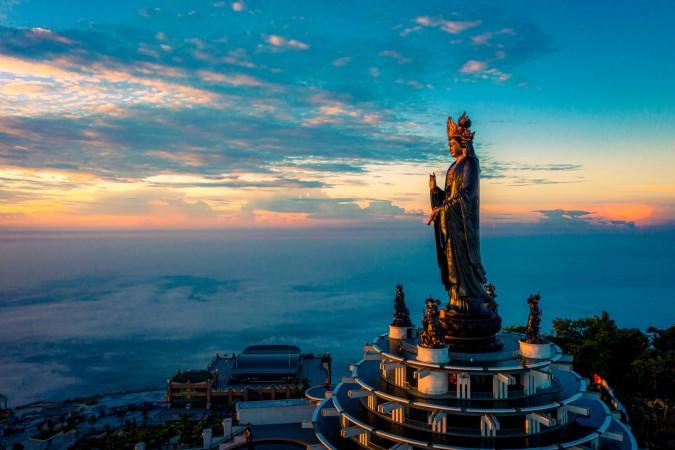
Black Virgin Mountain or Ba Den Mountain in Tay Ninh - © VnExpress
Must-Try Dishes in Tay Ninh
Tay Ninh’s culinary offerings are as diverse as they are delicious, reflecting the region’s rich agricultural resources and culinary traditions. Each of these dishes reflects the diverse and rich culinary heritage of Tay Ninh, offering a range of flavors and textures that are sure to delight any food enthusiast.
- Banh Trang Tay Ninh (Tay Ninh Rice Papers): Banh Trang Tay Ninh is a renowned local specialty. This rice paper, made from sun-dried rice flour, is often enjoyed wrapped around fresh vegetables, herbs, and grilled meats. Its versatility makes it a staple in many traditional dishes and a must-try for visitors.
- Banh Canh Trang Bang (Trang Bang Thick Noodle Soup): Banh Canh Trang Bang is a comforting noodle soup made with thick, chewy noodles and a savory broth. Typically garnished with pork, shrimp, and fresh herbs, this dish offers a satisfying and flavorful experience.
- Banh Xeo (Vietnamese savory pancakes): Banh Xeo are made from rice flour and turmeric, giving them a distinctive golden color. Filled with shrimp, pork, and bean sprouts, these crispy pancakes are served with fresh lettuce, herbs, and a tangy dipping sauce.
- Ca Loc Nuong (Grilled Snakehead Fish): Grilled Snakehead Fish is a popular local dish in Tay Ninh. The fish is marinated with a blend of spices and grilled until crispy. It is typically served with fresh herbs, vegetables, and a spicy dipping sauce, offering a delightful combination of flavors.
- Canh Chua Ca (Sour Fish Soup): This dish is a tangy and aromatic soup made with fresh fish, tomatoes, pineapple, and tamarind. It’s a refreshing and flavorful dish that balances sweet, sour, and savory notes.
Craving Vietnamese food? Discover more about Vietnam cuisine here.

Banh Trang Tay Ninh (Tay Ninh Rice Papers) - © Vietnam Tourism
Festivals & Local Celebrations
Tay Ninh’s festivals and local celebrations are vibrant expressions of its cultural heritage. Each of these festivals offers a unique window into the cultural richness and community spirit of Tay Ninh, providing visitors with memorable experiences and a deeper understanding of the region’s traditions.
Cao Dai Festivals
The Cao Dai Festivals are important events for the Cao Dai society, and they are hosted in the majestic Cao Dai Temple. Celebrated several times throughout the year, these festivals commemorate important dates in the Cao Dai calendar, such as the Cao Dai New Year and the Feast of the Mother of the West. During these festivals, the temple comes alive with colorful processions, vibrant costumes, and intricate rituals. Devotees gather for ceremonial prayers, musical performances, and elaborate rituals that highlight the unique syncretic nature of the Cao Dai faith, blending elements of Buddhism, Taoism, Confucianism, and Christianity.
Mid-Autumn Festival
Tet Trung Thu, also known as the Mid-Autumn Festival, is a cheerful event held in September or October. This festival is particularly popular among children, who enjoy colorful lantern parades and traditional games. The festival is known for its special mooncakes, which are enjoyed by families as they come together to celebrate the harvest and the full moon. In Tay Ninh, the festivities include lively street performances, traditional music, and a range of local snacks, creating a festive atmosphere that brings the community together.
Traditional Village Festivals
Throughout the year, various traditional village festivals take place in Tay Ninh, each showcasing local customs and agricultural practices. These festivals often feature traditional music, dance performances, and folk games that reflect the cultural heritage of the region. For example, the Long Hoa Village Festival includes a series of activities such as traditional boat races and cultural performances, celebrating the village’s history and local traditions. These festivals provide visitors with a genuine experience of Tay Ninh’s community life and cultural practices.
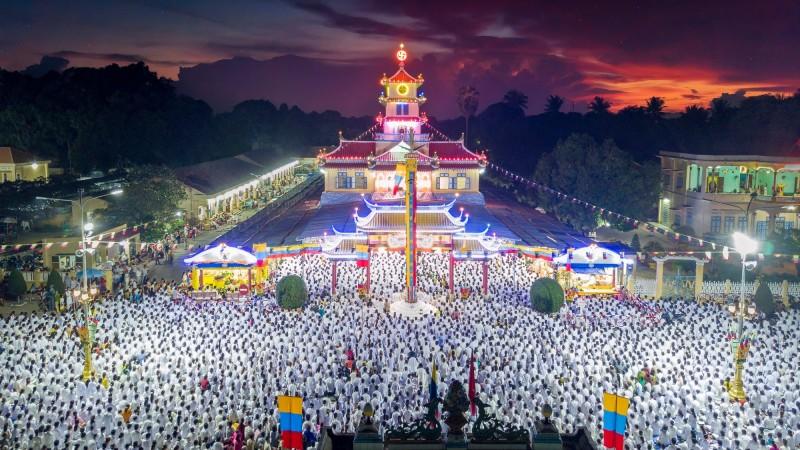
Cao Dai Festivals - © Nguoi Lao Dong
What to Do in Tay Ninh
Tay Ninh offers a range of activities that cater to different interests, from nature enthusiasts to history buffs:
- Hiking Ba Den Mountain: Explore the natural beauty of Tay Ninh with hiking and trekking opportunities, especially around Ba Den Mountain. The trails offer stunning views and a chance to connect with the region’s natural landscape. From here, you can visit other surrounding areas if you enjoy hiking
- Dau Tieng Lake Boat Tours: Enjoy scenic boat tours on Dau Tieng Lake, a picturesque reservoir perfect for a relaxing day on the water. Boat tours provide an opportunity to appreciate the serene environment and engage in recreational activities.
- Cao Dai Temple Cultural Tours: Participate in cultural tours that include visits to the Cao Dai Temple and local markets. These tours offer insight into Tay Ninh’s religious practices and daily life, enhancing your understanding of the region’s cultural diversity.
- Tay Ninh Cycling Tours: Discover Tay Ninh’s charming villages and countryside on a cycling tour. Cycling allows you to experience the local landscape at your own pace and interact with residents along the way.
Shopping in Tay Ninh
Tay Ninh provides a vibrant shopping experience with a variety of options to suit different tastes and interests:
- Ben Cau Market: This is a bustling local market where visitors can find fresh produce, local snacks, and traditional goods. The market is a great place to experience the lively atmosphere, sample local delicacies, and purchase souvenirs such as traditional crafts and textiles.
- Specialty Stores: Explore specialty stores that offer Tay Ninh Rice Papers and other local products. These stores provide an opportunity to buy high-quality rice paper, local snacks, and unique culinary items. It’s an excellent way to take home a taste of Tay Ninh’s culinary traditions.
- Artisan Crafts: Tay Ninh is known for its traditional crafts, including pottery, textiles, and woodwork. Shops and markets often feature handcrafted items that make for meaningful souvenirs. Look for intricately designed pottery or handwoven textiles that reflect the region’s artisanal skills.
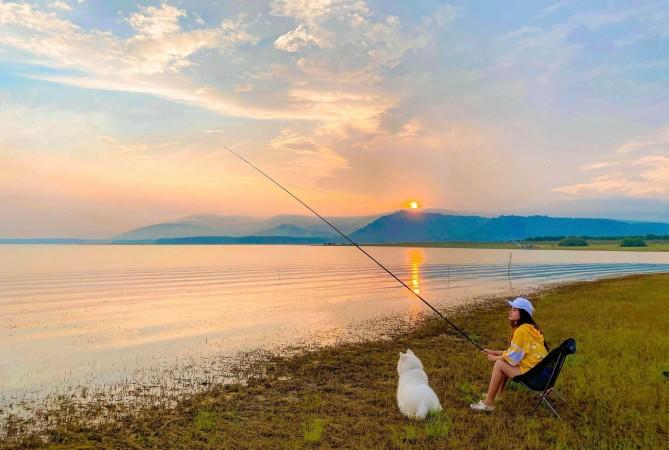
Experience camping and fishing at Dau Tieng Lake after your boat tours - © VnExpress
Weather in Tay Ninh: Best Time to Visit
Tay Ninh’s weather plays a significant role in shaping the tourism experience throughout the year. Understanding the seasonal trends can help you plan your visit to make the most of your trip.
Dry Season in Tay Ninh
The dry season in Tay Ninh is characterized by warm, sunny weather and low humidity, making it the peak tourist season. November to March offers the most favorable conditions for outdoor activities and sightseeing. With temperatures ranging from 25°C to 35°C (77°F to 95°F), it’s an ideal time for hiking, exploring Ba Den Mountain, and enjoying boat tours on Dau Tieng Lake. The clear skies and minimal rainfall also make it perfect for cultural tours and attending local festivals. This period is highly popular among travelers, so booking accommodations and tours in advance is recommended.
The dry season is a favourable time to visit many regions in southern Vietnam, such as Tay Ninh and My Tho. Learn more about My Tho here.
Wet Season in Tay Ninh
The wet season in Tay Ninh brings higher humidity and frequent rain showers, typically occurring in the late afternoon or evening. From May to October, temperatures range from 25°C to 30°C (77°F to 86°F), with the odd downpour adding to the lush, green scenery. While the rain might limit outdoor activities at times, it also creates a serene atmosphere for those seeking a quieter travel experience. The wet season is a great time to enjoy indoor attractions, explore local markets, and experience cultural events with fewer crowds.
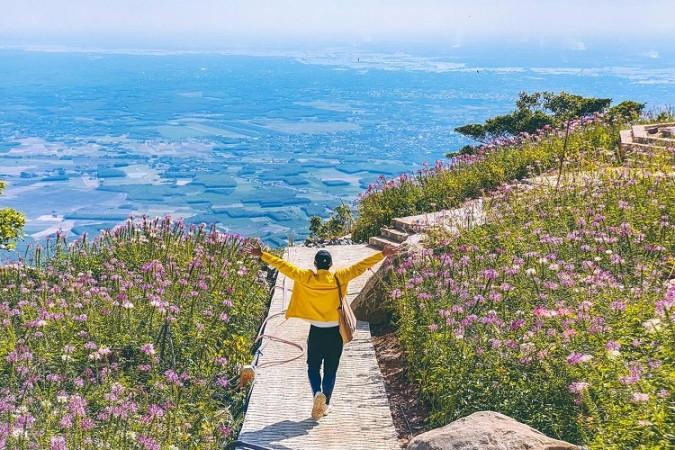
Dry Season in Tay Ninh is the best time to hike Ba Den Mountain - © CafeBiz
Essential Travel Information
Getting Around Tay Ninh
- Local Buses: Local buses provide an affordable way to travel within Tay Ninh and to nearby cities. Bus routes are well-connected, making it easy to reach major attractions and towns.
- Motorbike: Motorbike is a popular option for exploring Tay Ninh at your own pace. Many rental shops offer motorbikes and scooters, allowing you to navigate the area and visit local attractions comfortably.
- Taxis and Ride-Hailing Services: Taxi services are widely available in Tay Ninh, offering a convenient way to get around the city and surrounding areas. These services offer a dependable and convenient means of transportation.
- Bicycle: Bicycle is a great option for a leisurely exploration of Tay Ninh’s countryside and local neighborhoods. Cycling allows you to enjoy the scenic views and interact with the local community.
ATM & Banking Services
Tay Ninh offers convenient ATM and banking services, particularly in urban areas like Tay Ninh City, where travelers can easily access ATMs that accept major international cards. These ATMs are strategically located near popular tourist spots, hotels, and shopping areas, ensuring easy cash withdrawals. Currency exchange services are readily available at banks and exchange counters, making it simple to exchange major international currencies, though it's wise to carry some local currency for smaller transactions.
Where to Stay in Tay Ninh
- Hotels: Tay Ninh City has a range of hotels, from budget-friendly to luxury accommodations. Options include well-known chains and boutique hotels that offer modern amenities, comfortable rooms, and convenient locations.
- Resorts: For those seeking a higher-end experience, resorts around Dau Tieng Lake and Ba Den Mountain offer elegant lodgings with breathtaking views and vast facilities that enhance the stay with features such as swimming pools, spas, and fine cuisine.
- Homestays: Homestays are often located in rural areas, providing a more immersive cultural experience. This type of accommodation provides insight into daily life in Tay Ninh and offers a chance to experience traditional hospitality.
Articles for you

Explore Yala National Park - Sri Lanka Travel, Asia
Tucked away in Sri Lanka’s southeastern corner, Yala National Park is where wild nature meets deep tradition. Known worldwide for its leopard population, the park is also home to elephants, sloth bears, crocodiles, and hundreds of bird species. Beyond wildlife, Yala opens doors to a cultural landscape dotted with ancient temples, Buddhist ruins, and coastal villages. For travelers seeking more than just a safari, Yala offers a chance to explore eco-tourism, local communities, and sacred heritage sites.
Population: The Yala National Park area doesn’t have a human population.
Economy: The economy around Yala National Park thrives on a blend of eco-tourism, agriculture, and local services. Safari tours, eco-lodges, and cultural experiences drive steady income for nearby towns like Tissamaharama and Kataragama, supporting thousands of families.
Landmarks: Famous for Block I of Yala and wildlife encounters, including elephants, sloth bears, crocodiles, and exotic bird species.

Explore Galle - Sri Lanka Travel, Asia
Nestled on Sri Lanka’s southern coastline, Galle is a vibrant city where history meets the sea. Its cobbled streets, colonial architecture, and serene beaches make it a must-visit destination for travelers seeking a blend of culture, adventure, and relaxation. A UNESCO World Heritage site, Galle captivates visitors with its Dutch Fort, bustling markets, and friendly locals. Whether you’re exploring the ramparts at sunset or savoring fresh seafood by the shore, Galle promises an unforgettable journey into Sri Lanka’s heritage.
Population: Approximately 113,000 in 2023.
Economy: Galle’s economy thrives on tourism, trade, and fisheries. The city’s historic fort, colonial architecture, and coastal charm draw thousands of international visitors each year, making tourism its main economic driver. Fishing remains vital for local livelihoods, supplying fresh seafood across the region.
Landmarks: Famous for the Galle Fort, Dutch Reformed Church & Maritime Museum, and Unawatuna Beach.

Explore Bentota - Sri Lanka Travel, Asia
Nestled along Sri Lanka’s southwestern coast, Bentota is a tropical paradise that blends golden beaches, vibrant culture, and thrilling adventures. Famous for its calm waters, luxury resorts, and scenic river estuary, Bentota has become a top destination for travelers seeking both relaxation and authentic experiences. From serene beach walks at sunrise to adrenaline-pumping water sports, this coastal town offers a perfect balance of leisure and exploration. With its proximity to Colombo and Galle, Bentota is easy to reach, making it an ideal stop for both short escapes and extended holidays.
Population: Approximately 37,000 in 2023.
Economy: Bentota’s economy thrives mainly on tourism, which drives local businesses such as hotels, restaurants, and wellness retreats. The town also benefits from fishing, coconut cultivation, and handicrafts like wood carving and batik textiles. Many residents rely on the growing demand for water sports and Ayurvedic treatments, making tourism the backbone of both income and employment in the area.
Landmarks: Famous for Bentota Beach, Bentota River Safari, and Kande Vihara Temple.

Explore Mirissa - Sri Lanka Travel, Asia
Mirissa is a charming coastal town on Sri Lanka’s southern shoreline. Known for its golden beaches, turquoise waters, and vibrant marine life, it has become a must-visit stop for travelers exploring the island. Many come for whale watching, surfing, and sunset views at Coconut Tree Hill, but Mirissa offers much more than postcard beauty. The fishing boats you see anchored by the bay carry generations of stories. Local traditions, delicious cuisine, and a laid-back rhythm of life shape every visitor’s experience.
Population: Approximately 4,700 in 2023.
Economy: Mirissa’s economy is largely shaped by its coastal location. Fishing has long been the backbone of local livelihoods, with generations relying on the Indian Ocean for income. In recent decades, tourism has become the main driver of growth, thanks to whale watching, surfing, and beachside hospitality.
Landmarks: Famous for Mirissa Beach, Coconut Tree Hill, and Parrot Rock Bridge.

Explore Nuwara Eliya - Sri Lanka Travel, Asia
Tucked away in the Central Highlands of Sri Lanka, Nuwara Eliya is often called “Little England”. With its rolling tea plantations, cool misty mornings, and colonial charm, this mountain town feels like a step into another world. Travelers come here to breathe fresh air, walk through flower gardens, sip the finest Ceylon Tea, and enjoy a pace of life far from the island’s busy cities. Whether you’re drawn by scenic landscapes, heritage architecture, or the warmth of its people, Nuwara Eliya is a destination that blends nature, culture, and history in perfect harmony.
Population: Approximately 781,000 in 2023.
Economy: Nuwara Eliya’s economy thrives mainly on tea production, as it sits in the heart of Sri Lanka’s central highlands, famous worldwide for Ceylon Tea. The city also benefits from a growing tourism industry, attracting visitors with its colonial charm, cool climate, and scenic landscapes.
Landmarks: Famous for Gregory Lake, Hakgala Botanical Garden, and Victoria Park.

Explore Sukau - Malaysia Travel, Asia
Nestled on the banks of the Kinabatangan River in Sabah, Malaysian Borneo, Sukau is a destination where wildlife, culture, and conservation come together. Known as one of Asia’s top spots for river safaris and eco-tourism, this quiet village offers a front-row seat to encounters with Bornean orangutans, pygmy elephants, proboscis monkeys, and exotic birdlife.
Population: Approximately 1,400 in 2019.
Economy: Sukau’s economy is shaped by its riverine location and natural resources. Traditionally, the Orang Sungai community relied on fishing, small-scale farming, and forest gathering for their livelihood. Today, the village has shifted toward eco-tourism, with river cruises, jungle trekking, and homestays providing income.
Landmarks: Famous for the Kinabatangan River cruises, Gomantong Caves, and Ox-bow lakes and wetlands.
